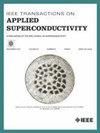应用超导屏蔽线圈和磁通量分流器降低高温超导磁体的交流损耗
IF 1.8
3区 物理与天体物理
Q3 ENGINEERING, ELECTRICAL & ELECTRONIC
引用次数: 0
摘要
设计了一种10 T快速升温高温超导(HTS)磁体,用于表征新型稀土永磁材料。然而,与快速升温过程相关的交流损耗是关键的技术挑战之一。本研究的重点是评估损耗降低策略的有效性-超导屏蔽线圈(SSC)和磁通量分流器(MFD) -无论是单独还是组合。作为该项目的第一步,对小型磁体中的交流损耗进行了数值研究,结果表明,SSC、MFD及其组合分别可使损耗降低约32%、71%和90%。通过分析临界电流与交流损耗之间的关系,我们发现输运电流的频率和幅值显著影响SSC的有效性。在随后的10-T磁体仿真中,当使用SSC、MFD和两者时,交流损耗降低高达34%、57%和71%。仿真结果表明,与MFD相比,SSC的有效性对强磁场的敏感性较低;MFD对10-T磁体仍然有效,即使超出其饱和场;SSC和MFD的组合配置是降低交流损耗最有效的方法。本文章由计算机程序翻译,如有差异,请以英文原文为准。
AC Loss Reduction in HTS Magnets by Applying Superconducting Shielding Coils and Magnetic Flux Diverters
A 10 T fast-ramping high-temperature superconducting (HTS) magnet is being designed to characterize new rare-earth permanent magnet materials. However, AC loss associated with the fast-ramping process is one of the key technical challenges. This study focuses on evaluating the effectiveness of loss-reduction strategies—superconducting shielding coils (SSC) and magnetic flux diverters (MFD)—both individually and in combination. As the first step of the project, AC loss in a small-scale magnet was numerically studied, resulting in loss reduction of approximately 32%, 71%, and 90% with SSC, MFD, and their combination, respectively. By analyzing the correlation between critical current and AC loss, we found that the frequency and amplitude of the transport current significantly influence the effectiveness of SSC. In the subsequent simulation for the 10-T magnet, AC loss reduction is up to 34%, 57%, and 71% when using SSC, MFD and both. The simulation results indicate that the effectiveness of SSC is less sensitive to high magnetic fields than that of MFD; MFD is still effective for the 10-T magnet, even beyond its saturation field; the combined configuration of SSC and MFD is the most efficient method for AC loss reduction.
求助全文
通过发布文献求助,成功后即可免费获取论文全文。
去求助
来源期刊

IEEE Transactions on Applied Superconductivity
工程技术-工程:电子与电气
CiteScore
3.50
自引率
33.30%
发文量
650
审稿时长
2.3 months
期刊介绍:
IEEE Transactions on Applied Superconductivity (TAS) contains articles on the applications of superconductivity and other relevant technology. Electronic applications include analog and digital circuits employing thin films and active devices such as Josephson junctions. Large scale applications include magnets for power applications such as motors and generators, for magnetic resonance, for accelerators, and cable applications such as power transmission.
 求助内容:
求助内容: 应助结果提醒方式:
应助结果提醒方式:


